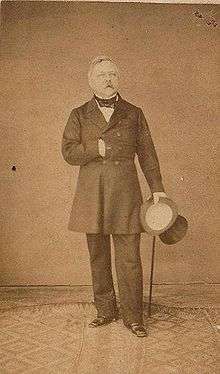White Haitians
White Haitians (French: blanc haïtiens [blɒŋ aisiɛ̃]; Haitian Creole: blan ayisyen)[1] are Haitians of predominantly European, and in some cases Levantine descent.[2]



History
European conquest and colonization
The presence of whites in Haiti dates back to the founding of La Navidad, the first European settlement in the Americas by Christopher Columbus in 1492. It was built from the timbers of his wrecked ship Santa María, during his first voyage in December 1492. When he returned in 1493 on his second voyage he found the settlement had been destroyed and all 39 settlers killed. Columbus continued east and founded a new settlement at La Isabela on the territory of the present-day Dominican Republic in 1493. The capital of the colony was moved to Santo Domingo in 1496, on the south east coast of the island also in the territory of the present-day Dominican Republic. The Spanish returned to western Hispaniola in 1502, establishing a settlement at Yaguana, near modern-day Léogâne. A second settlement was established on the north coast in 1504 called Puerto Real near modern Fort-Liberté – which in 1578 was relocated to a nearby site and renamed Bayaha.[3][4][5] The presence of precious metals such as gold boosted migration of thousands of Spaniards to Hispaniola seeking easy wealth. They tried to enslave the native inhabitants, but many of these died of diseases, and those that survived did not make good slaves.
The settlement of Yacanagua was burnt to the ground three times in its just over a century long existence as a Spanish settlement, first by French pirates in 1543, again on 27 May 1592 by a 110 strong landing party from a 4 ship English naval squadron led by Christopher Newport in his flagship Golden Dragon, who destroyed all 150 houses in the settlement, and finally by the Spanish themselves in 1605, for reasons set out below.[6]
In 1595, the Spanish, frustrated by the twenty-year rebellion of their Dutch subjects, closed their home ports to rebel shipping from the Netherlands, cutting them off from the critical salt supplies necessary for their herring industry. The Dutch responded by sourcing new salt supplies from Spanish America where colonists were more than happy to trade. So large numbers of Dutch traders/pirates joined their English and French brethren trading on the remote coasts of Hispaniola. In 1605, Spain was infuriated that Spanish settlements on the northern and western coasts of the island persisted in carrying out large scale and illegal trade with the Dutch, who were at that time fighting a war of independence against Spain in Europe and the English, a very recent enemy state, and so decided to forcibly resettle their inhabitants closer to the city of Santo Domingo.[7] This action, known as the Devastaciones de Osorio, proved disastrous; more than half of the resettled colonists died of starvation or disease, over 100,000 cattle were abandoned, and many slaves escaped.[8] Five of the existing thirteen settlements on the island were brutally razed by Spanish troops including the two settlements on the territory of present-day Haiti, La Yaguana, and Bayaja. Many of the inhabitants fought, escaped to the jungle, or fled to the safety of passing Dutch ships[9] This Spanish action was counterproductive as English, Dutch, and French pirates were now free to establish bases on the island's abandoned northern and western coasts, where wild cattle were now plentiful and free.
Saint-Domingue

In the early seventeenth century, the Spanish government ordered the evacuation of the northern and western coast of the island, and forcing the relocation to areas close to the city of Santo Domingo, to prevent the pirates from other European nations. This ended up being counterproductive to Spain, because in 1625 the pirates and French buccaneers began to establish settlements on the island of Tortuga and in a strip north of Hispaniola surrounding Port-de-Paix and were soon joined by like-minded English and Dutch privateers and pirates, who formed a lawless international community that survived by preying on Spanish ships and hunting wild cattle. Although the Spanish destroyed the buccaneers' settlements in 1629, 1635, 1638 and 1654, on each occasion they returned. In 1655, the newly established English administration on Jamaica sponsored the re-occupation of Tortuga under Elias Watts as governor. In 1660, the English made the mistake of replacing Watts as governor by a Frenchman Jeremie Deschamps,[10] on condition he defended English interests. Deschamps on taking control of the island proclaimed for the King of France, set up French colours, and defeated several English attempts to reclaim the island. It is from this point in 1660 that unbroken French rule in Haiti begins.[11] In 1663, Deschamps founded a French settlement Léogâne on the western coast of the island on the abandoned site of the former Spanish town of Yaguana.
In 1664, the newly established French West India Company took control of the new colony, and France formally claimed control of the western portion of the island of Hispaniola. In 1665, they established a French settlement on the mainland of Hispaniola opposite Tortuga at Port-de-Paix. In 1670, the headland of Cap-Français (now Cap-Haïtien), was settled further to the east along the northern coast. In 1676, the colonial capital was moved from Tortuga to Port-de-Paix. In 1684, the French and Spanish signed the Treaty of Ratisbon that included provisions to suppress the actions of the Caribbean privateers, which effectively ended the era of the buccaneers on Tortuga, many being employed by the French Crown to hunt down any of their former comrades who preferred to turn outright pirate.[12] Under the 1697 Treaty of Ryswick, Spain officially ceded the western three-eighths of Hispaniola[13][14] to France which renamed the colony Saint-Domingue. By that time, planters outnumbered buccaneers and, with the encouragement of Louis XIV, they had begun to grow tobacco, indigo, cotton, and cacao on the fertile northern plain, thus prompting the importation of African slaves.
In 1777, France and Spain signed a border treaty, in which the western and northwestern coast of Hispaniola would be French and the rest of the island would be Spanish. By 1780 Saint-Domingue was the richest colony in the world, even than all the British Thirteen Colonies and the West Indies together. The French established an economy based on the production and export of sugar sustained on the forced labor of black slaves imported from west and central Africa. Slavery of blacks was characterized as one of the most ruthless in which terror and severe punishments were applied to slaves.[15]
By 1789, the population was composed as follows:[16][17][18]
- 40,000 Grand-blancs (literally "Great whites" in French) and Petit-blancs ("Little whites")
- 28,000 Sang-melés (French for: "Mixed blood") or free people of color.
- 452,000 slaves
The white population were 8% of Saint-Domingue’s population, but they owned 70% of the wealth and 75% of the slaves in the colony. The mulatto population were 5% of the population and had the 30% of the wealth. The slaves were 87% of the population.[18]
Haitian Revolution

When the French Revolution started, the ideas of freedom among men spread in Saint-Domingue. Blacks, and the majority African descendants such as Jean-Jacques Dessalines, rebelled against their white masters and began a genocide against the French. In 1791, more than a thousand were killed.[18] In order to preserve their lives, they fled Saint-Domingue. The wealthy grand-blancs, returned to France or went to French Louisiana, but the petit-blancs who did not have many resources were compelled to move to the eastern side of Hispaniola, Cuba, and Puerto Rico.[19] Notably, there were many sang-melés, some of which fled from Saint-Domingue as well, and settled in neighboring islands, mostly Puerto Rico and Cuba.
Most French colonists died or fled Saint-Domingue during the Haitian Revolution and the surviving remainder were either annihilated in the 1804 Haiti Massacre or kept if thought to be of some use to the country's development, such as doctors, teachers, engineers and were not to be harmed in any way.[20] However, prior to the United States occupation of Haiti, whites were prohibited from both Haitian citizenship and the right to purchase land or any property.[21]
Origins
Before the Haitian Revolution, Haitians were categorized under three major categories: white, black and mulatto but were far more complex in practice that involved the coarseness of one's hair, nose measurements and other facial features.[22]
Demographics
Today, a group of Haitians are of direct descendants of the Frenchmen who were saved from the massacre.[20] As of 2013, people of solely European descent are a small minority in Haiti. The combined population of whites and mulattoes constitutes 5% of the population, roughly half a million people.[23] People born to foreigners on Haitian soil are not automatically Haitian citizens due to the jus sanguinis (from Latin, meaning "right of blood") principle of nationality law.[24]
To note, according to the Haitian constitution since the time of independence, all citizens are to be referred to as black, where all races are considered equal to avoid prejudice.[25] The creole term nèg is derived from the French word negre (to mean "black") and is used normatively to mean a person.[22] A Haitian man is always a nèg, even if he is of European descent where he would be called a nèg blan ("white guy"), and his counterpart being nèg nwa ("black guy"); all with no racist overtones.[1] Foreigners are always referred to as simply blan regardless of skin-tone, denoting a double meaning for the word.[2]
In the countryside, it is common to hear a poor light-skinned person called ti-wouj (little red), ti-blan (little white), or simply "blan" rather than a milat (mulatto), which is commonly being used to exclude individuals at the bottom of the social ladder as the term "mulatto" historically coincides with people who were more privileged.[26]
See also
- French Haitians
- German Haitian
- Italian Haitian
- Lebanese Haitian
- Mulatto Haitian
- Polish Haitian
- Syrian Haitian
- White Latin Americans
- History of the Jews in Haiti
References
- 1 2 Warner, R. Stephen; Wittner, Judith G. (1998). Gatherings in Diaspora: Religious Communities and the New Immigration. Temple University. p. 155. ISBN 1566396131. Retrieved 8 June 2015.
- 1 2 Katz, Jonathan M. (2013). The Big Truck That Went By: How the World Came to Save Haiti and Left Behind a Disaster. p. 56. ISBN 9780230341876. Retrieved 9 June 2015.
- ↑ "Fort-Liberté: A captivating Site". Haitian Treasures. Retrieved 2010-07-01.
- ↑ Clammer, Paul; Michael Grosberg; Jens Porup (2008). Dominican Republic and Haiti. Lonely Planet. pp. 339, 330–333. ISBN 1-74104-292-5. Retrieved 2010-07-01.
- ↑ "Population of Fort Liberté, Haiti". Mongabay.com. Retrieved 2010-07-01.
- ↑ Historic Cities of the Americas: An Illustrated Encyclopedia (2005). David Marley. Page 121
- ↑ Knight, Franklin, The Caribbean: The Genesis of a Fragmented Nationalism, 3rd ed. p. 54 New York, Oxford University Press 1990.
- ↑ Rough Guide to the Dominican Republic, p. 352.
- ↑ Peasants and Religion: A Socioeconomic Study of Dios Olivorio and the Palma Sola Movement in the Dominican Republic. Jan Lundius & Mats Lundah. Routledge 2000, p. 397.
- ↑ de Saint-Méry, Moreau (1797). Description topographique, physique, civile, politique et historique de la partie française de l'isle Saint-Domingue (réédition, 3 volumes, Paris, Société française d'histoire d'outre-mer, 1984 ed.). pp. 667–670.
- ↑ The Buccaneers in the West Indies in the XVII Century
- ↑ Short History of Tortuga, 1625-1688
- ↑ "Hispaniola Article". Britannica.com. Retrieved 4 January 2014.
- ↑ "Dominican Republic 2014". Retrieved 24 April 2014.
- ↑ Robert Hein, Written in Blood: The History of the Haitian People (University Press of America: Lantham, Md., 1996)
- ↑ Leyburn, James. El pueblo haitiano.
- ↑ James, C.L.R. "The Black Jacobins". p. 55.
- 1 2 3 Dr. Mu-Kien Adriana Sang (1999). Dr. Mu-Kien Adriana Sang, ed. Historia Dominicana: Ayer y Hoy (in Spanish). SUSAETA Ediciones Dominicanas. pp. 78–79, 81.
- ↑ French colonization in Cuba, 1791-1809
- 1 2 David Ritter (2010). Forgotten faces of Haiti (Part 1). Haiti: Carib Productions. Event occurs at 06:30. Retrieved 1 August 2010.
- ↑ F. James Davis, Who is Black?: One Nation’s Definition (University Park PA, 1991), 87-88.
- 1 2 Averill, Gabe (1997). A Day for the Hunter, a Day for the Prey: Popular Music and Power in Haiti. p. 5. ISBN 0226032914. Retrieved 9 June 2015.
- ↑ "CIA - The World Factbook -- Haiti". CIA. Archived from the original on 7 May 2013. Retrieved 2013-06-04.
- ↑ Paraison, Edwin (9 May 2009). "Doble nacionalidad; La Constitución haitiana en la diáspora" (in Spanish). Hoy. Retrieved 13 April 2014.
- ↑ Zéphir, Flore (1996). Haitian Immigrants in Black America: A Sociological and Sociolinguistic Portrait. Greenwood Publishing Group. pp. 54–55. ISBN 0-89789-451-0.
- ↑ Gregory, Steven (1996). Race. p. 172. ISBN 0813521092. Retrieved 9 June 2015.